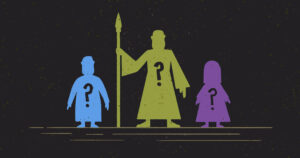Did the Bible Copy Different Spiritual Myths and Legends?
Of their guide The Laughing Jesus, authors Timothy Freke and Peter Gandy expressed the idea that the Christian Bible developed from different myths. “Every thriller faith,” they wrote, “taught its personal model of the parable of the dying and resurrecting Godman, who was recognized by completely different names somewhere else. In Egypt, the place the mysteries started, he was Osiris. In Greece he grew to become Dionysus, in Asia Minor, he is called Attis, in Syria he’s Adonis, in Persia he’s Mithras, in Alexandria he’s Serapis, to call a number of.”
This citation will get the gist of their opinion throughout. The authors — like many non-believers — assume Christianity is attention-grabbing, however not that unique.
Regardless of taking quite a few Bible and Christian philosophy courses, I solely lately realized that lots of people assume this manner. Because the idea of Christianity evolving from different religions is new to me, I’d like to discover it with you. We’ll begin by taking a look at why the idea is so prevalent, then segue into what makes it problematic.
Why It’s Well-liked
In line with apologist Dr. Pat Zukeran, non-believers assume Christianity grew from pagan practices as a result of there are outstanding parallels between the 2. These parallels embrace:
- Mithras— The Persian (and ultimately Roman) god of the solar, oaths, and justice. In line with Zukeran, Mithras was immaculately conceived, traveled with 12 disciples to whom he promised everlasting life, and sacrificed himself for the world.
- Osiris— The Egyptian king of the Underworld. He was killed by Seth, the embodiment of chaos and evil, however grew to become choose over the lifeless and exercised energy over the dwelling by way of his son.
- Dionysus— A Greco-Roman nature god of fruitfulness and merriment. Like Jesus, Dionysus was recognized for turning water into wine.
- The Epic of Gilgamesh— A Mesopotamian poem a couple of two-thirds-divine king named Gilgamesh. His travels entailed forbidden timber and a worldwide flood.
Why It’s Mistaken
When confronted with such a putting resemblance between Christianity and paganism, it’s no marvel non-believers really feel safe of their non-belief. Nevertheless, Zukeran identified two main flaws within the concept: One, it’s not logically sound; and two, it ignores the elemental variations between the Christian and pagan narratives.
1. The Logical Fallacies
As strong as the idea could seem at first look, a more in-depth look reveals some flaws within the logic. Zukerman calls the primary one the composite fallacy. Folks commit it by lumping many or all pagan religions into one unit earlier than evaluating them to Christianity.
Extra religions equal extra frequent factors equal extra proof. Nevertheless, when you deal with every pagan perception as its personal entity earlier than evaluating it to our personal religion, you’ll solely discover a number of surface-level connections.
Zukerman additionally identified one thing he known as the terminological fallacy. He states that whereas some phrases exist in each Christian and pagan faiths, they’re typically used fairly otherwise. The phrase “resurrection” is a superb instance:
Whereas Osiris is claimed to have resurrected from the lifeless, he doesn’t come again to life totally. He has to remain put within the Underworld and accept metaphorically dwelling by way of his descendants. Jesus, alternatively, got here again to life fairly actually. This distinction of definition proves that terminology alone is a poor level of comparability between religions.
One other frequent mistake non-believers make is committing the chronological fallacy. That is the belief that the thriller religions existed earlier than Christianity. There isn’t any archaeological proof that different thriller religions have been practiced in Palestine within the first century AD.
Moreover, Jews and early Christians confused the distinctiveness of their faith to the purpose that they loathed the thought of adopting gods, tales, or practices from different beliefs. In different phrases, they have been too darn cussed to let different concepts seep into their faith.
2. The Narrative Fallacies
Freke and Gandy cited the pagans’ early use of virgin births and demise and resurrection as proof that Christians have been shameless copycats. However the phrase “virgin start” means one thing radically completely different in every perception system. In pagan myths, a god lusts after and has a baby with a mortal lady.
Whereas Zeus isn’t any extra human than God is, his many mistresses don’t depend as virgin births as a result of there was intercourse concerned. There could not have been intercourse in Mithras’s start story, however that’s solely as a result of he wasn’t born in any respect; he sprouted fully-grown out of a rock. Neither state of affairs is corresponding to God sending the Spirit to the touch the Virgin Mary’s womb.
The little-G gods and the big-G God additionally disagree in regards to the topic of demise on a number of factors:
- The quantity of deaths— Pagans considered historical past as a cycle and never a line, so their gods repeatedly died and got here again. In distinction, Jesus solely died as soon as.
- The causes of deaths— In pagan myths, the gods by no means died voluntarily; they have been killed by emasculation, looking accidents, and different exterior forces. Jesus is the one god who selected to die and did so for a selfless purpose: to reunite humanity with the Father.
- The character of deaths— The demise of a pagan god or demigod was at all times a humiliating occasion of defeat. Jesus’ demise, alternatively, was the last word triumph in opposition to evil.
What Does This Imply?
We coated a whole lot of floor collectively right this moment, however many extra twists and turns await you as you discover this debate by yourself. It’s a protracted journey, however irrespective of the place your seek for information leads you, know God is by your aspect and desires you to seek out the reality. Search Him, and He’ll make it clear to you in His time.
©iStock/Getty Photographs Plus/MatiasEnElMundo


Initially revealed April 29, 2025.





